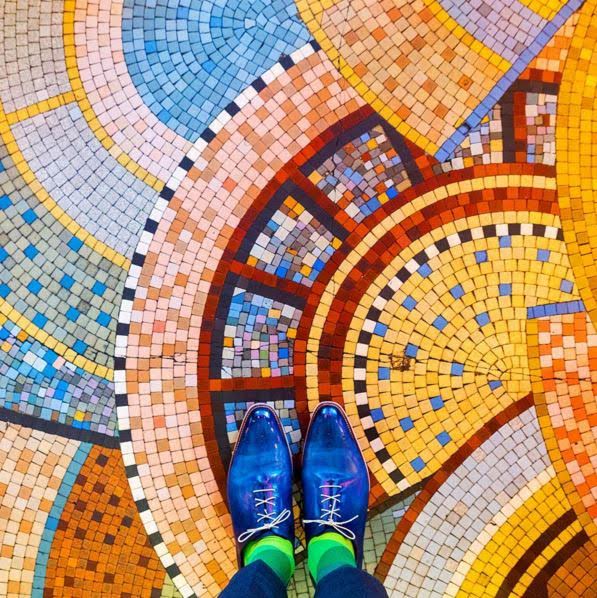The night my brother disappeared, I found a note underneath my pillow. It was written in pencil on a scrap of wide-ruled paper and said only this: Robert … When May 1 arrives you must go to Rue de Rivoli in Paris and find the man with the blue shoes.
OK, I’m being dramatic. My brother did write me a note and leave it under my pillow but he didn’t actually disappear, more like he told my parents that he had “bigger things to do than live among the monochromatic drudge of Milwaukee.”
Then he bought one of those backpacks I think Nepalese Sherpas use to summit Mount Everest and left our house one unusually warm day in February to the tune of my parents’ dismissive, cocktail-party laughter—“sure, honey, do whatever you want”—with a $30,000 check tucked into the front pocket of his jeans. Along with his desire to escape Wisconsin, the pair of faded jeans my brother always wore was really one of the only constants in his life. His hair, his attitude, his accent … everything about my brother was a study in color and volatility and that’s what I loved about him most.
I miss him every day, especially now that I’m actually in Paris on May 1 to do as he instructed, navigating narrow, cobblestone streets and small, pastel-colored patisseries to find the man with the blue shoes.
I’ve never been to Paris before. Heck, until this trip I hadn’t even traveled outside the Midwest and even then it was only once a year to visit Grandpa Joseph in Minneapolis and stay at his four-story walk-up apartment decorated with cat figurines and fake trees. (Oh, that’s a lie. I did go to Disney World with my nanny but I was three years old when Belinda took me and can’t remember a thing.)
Paris, from the hours I had so far spent inside it, seems like a different world. And not just because I don’t understand the language or am unfamiliar with the city but also because there’s a kind of magic here that falls in spellbound clumps onto everything in sight. Well, maybe “clumps” isn’t the right word. Substitute that for something more Parisian and très refined.
The best way to describe Paris is to say that all of it is a painting come alive, created with broad, impressionistic strokes—The Eiffel Tower! The Palais Garnier! The Avenue des Champs-Élysées!—and I can’t help but stare like I’m in some elaborate French museum and the entire city is an exhibit on display.
The bicycle rider ringing his bell—“fais attention!”—with two baguettes poking out from his front basket; the angry, dark-suited businessman who bumps into me as he spits out something beautiful-sounding and French into his cell phone, shaking his perfectly coiffed head my way; the appallingly chic woman wearing a purple beret and black jeans walking her off-white, standard poodle while smoking one of those long cigarettes …
I guess I’m just not used to so much vibrancy, especially when you compare it with what I know of life in Milwaukee, where our cheese is mostly colorless and the scenery swathed in a perpetual gray. Even the gum on the sidewalk looks a brighter shade of pink, happy to be sticking around in La Ville-Lumiere.
Today the weather is cool enough to need a light sweater but not cool enough for a scarf or gloves and I’m strolling with an ease I don’t really feel toward Rue de Rivoli.
“Monsieur McDowell, you should know that Rue de Rivoli is one of the most famous streets in all of Paris,” my concierge explained this morning after handing over a fold-up map of the city and a paper-wrapped pan de chocolat. “For your morning walk, compliments of Hôtel Adelais.”
Thank you, I told him, accepting the chocolate bread and on a whim, asked if he knew about a man with blue shoes who maybe walked along Rue de Rivoli.
“No, I have never heard of anyone like that,” said the concierge, scratching at his thick, gray mustache. “But there are all kinds of people in Paris. I have no doubt you’ll find one who wears blue shoes.”
The rotary phone on his desk rang.
“I’ve got to take this. Good luck on your adventure to the Rue de Rivoli!”
I really thought I saw him wink.
As it turns out, Rue de Rivoli isn’t one of those tiny Parisian streets with little cafes edging the sidewalks but instead is a big, wide ribbon of roadway lined on one side with gothic buildings and on the other with elegant lampposts that are, even in this late-afternoon dimness, still unlit.
It’s silly to think I’ll find him, the man with the blue shoes, when the city is so large and his shoes such a small part of Paris on the first of May.
“Stop being scared of what you don’t know and put one foot in front of the other and just keep walking,” my brother once told me and I heard his words echo in my ears so loud I thought he was practically speaking them next to me.
“Okay,” I tell him (but really tell myself) and look up to find myself at the entrance of some kind of outdoor shopping center. Of course in a city as strangely magical as Paris, it would be true that on the colorful, tiled entry to this shopping place, I see a pair of blue shoes.
“Ah, the wonders of Parisian floors,” says the man wearing them, his voice low, and he runs away before I have a chance to see more than his blue feet and bright green socks.
I walk to the spot where he just stood and see that fluttering on a red tile is a newly fallen piece of paper with a message written in handwriting I know well. “Thanks for finding me,” it reads but I shake my head because it isn’t right. I didn’t really find the man with the blue shoes. He found me.
[This tiny tale was inspired by the photography of Sebastian Erras, the Paris-based photographer behind hugely popular Instagram account, @ParisianFloors. You can learn more about his design and architecture-inspired photography here.]


